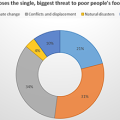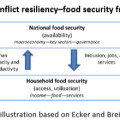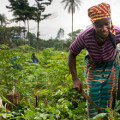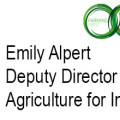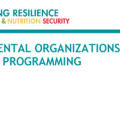
Knowledge Fair Participant Poll: Day 1 Results
1. Which of these shocks poses the single, biggest threat to poor people's food and nutrition security? 2. Is there a difference between resilience and vulnerability?
The resilience dividend
“Resilience will pay dividends for fragile communities who today face environmental, economic and nutritional bankruptcy. For the people in communities affected by droughts, floods and other shocks, a resilience approach allows multiple entry points for action that can both restore the productivity of lands and significantly improve well-being. Empowering resilient families to withstand shocks can >> Read more
Highlights from Conference Brief 3: Building resilience to conflict through food security policies and programs
Food insecurity and conflict often go hand-in-hand: a lack of food can ignite conflict and conflict can result in food shortages and unavailability. What’s more, the scope of the problem is far reaching, as more than one and a half billion people live in areas impacted by conflict. In their 2020 Conference Brief, Building Resilience >> Read more
Building resilience from within: Highlights from the opening session of the 2020 Conference
“If the past is any guide, we will face a barrage of shocks, both natural and man‐made, in the coming years. In just the past five years, we have seen a major earthquake in Haiti; drought in the Horn of Africa; earthquake, tsunami, and nuclear crisis in Japan; and conflicts that have left millions of >> Read more
African smallholder farm families have lost the elasticity to bounce back!
The following post by Lindiwe Majele Sibanda, Chief Executive Officer of the Africa-wide Food, Agriculture and Natural Resources Policy Analysis Network (FANRPAN), is an excerpted version of a story that originally appeared on the CGIAR Research Program on Water, Land and Ecosystems (WLE) Agriculture and Ecosystems Blog as part of their month-long series on Resilience. >> Read more
Can you be resilient on one acre or less?
Our guest author, Emily Alpert, Deputy Director of Agriculture for Impact, concludes our series of blog articles on resilience published in partnership with Farming First ahead of the conference “Building Resilience for Food and Nutrition Security” 15-17 May 2014. An acre is about the size of a football pitch. That might seem like a lot, but if your >> Read more
Highlights from 2020 Conference Brief 7: Nongovernmental organizations’ approaches to resilience programming
Stories of nongovernmental organizations (NGOs) providing emergency relief in the aftermath of natural disasters and other humanitarian crises are familiar parts of the news. When NGOs such as CARE or Mercy Corps support medical services in South Sudan or bring food to people affected by Typhoon Haiyan in the Philippines, we are not surprised. Less >> Read more
Highlights from Conference Brief 4: Local sources of resilience
Before government programs and international aid efforts, people coped with disasters, famine, conflicts, and other shocks by coming together as a community and relying on their networks—in other words, using social capital. Social capital, in the form of community-based organizations and social networks, has traditionally played an important, but largely unexplored, role in building resilience. >> Read more
Highlights from Conference Brief 18: Strengthening the links between resilience and nutrition
In the field of food policy, nutrition and resilience are strongly interlinked conceptually—and now Charlotte Dufour, Domitille Kauffmann, and Neil Marsland are trying to bind the two much more tightly in practice. Resilience, according to the Food and Agriculture Organization of the United Nations (FAO), is “the ability to prevent disasters and crises as well >> Read more
- « Previous Page
- 1
- 2
- 3
- 4
- 5
- …
- 7
- Next Page »

